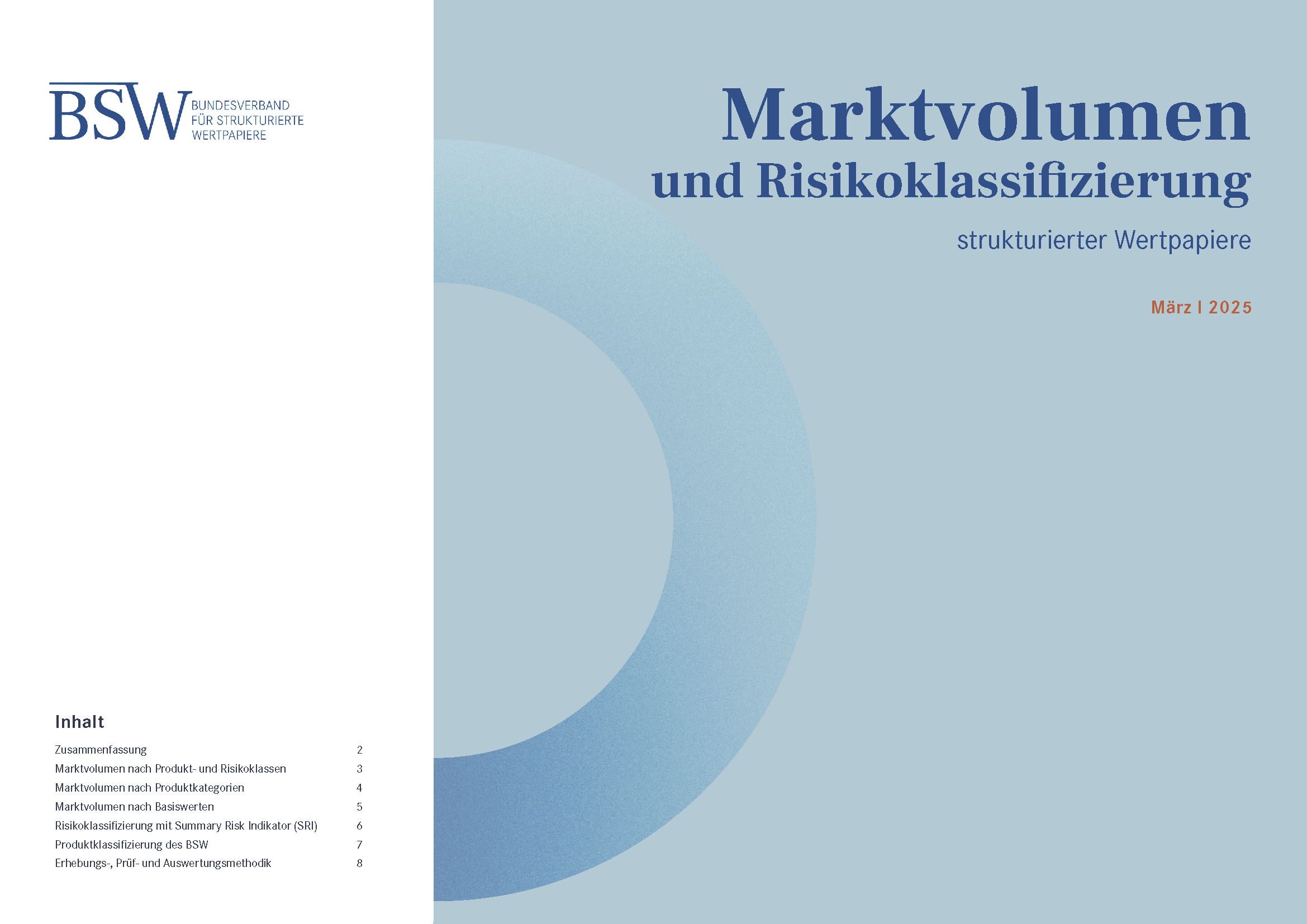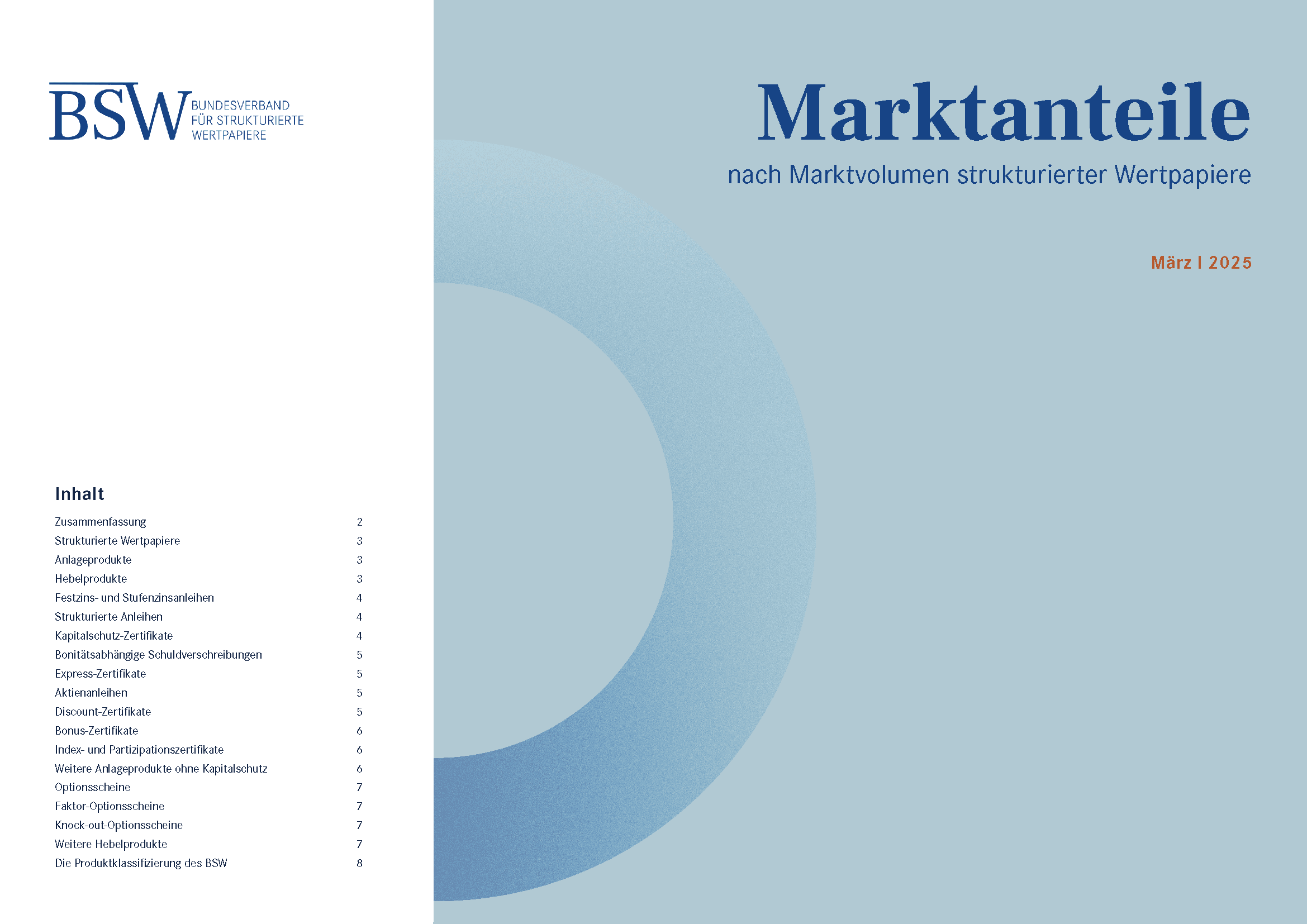
Market volume & market share by market volume
The BSW publishes quarterly statistics on market volume as well as monthly statistics on exchange turnover and the respective market shares of structured securities issuers, in order to create transparency with respect to the investment and trading volumes of the market.
The market volume indicates the cumulative outstanding total of placed (sold) structured securities for all BSW issuers and across all products as at specific reporting date (the end of each quarter).
The market share by market volume shows the shares of the individual BSW issuers in the placed (sold) market volume of structured securities.
The risk classification shows the shares of the market volume attributable to the seven Risk Classes (SRI) in accordance with the European legislation (the PRIIPs Regulation) as at the reporting date, with 1 being the lowest and 7 the highest Risk Class.
Legal basis, methodology, and application
Since 2018, all manufacturers of packaged retail investment and insurance-based products (PRIIPs) such as structured securities, funds, and ETFs as well as insurance products have been obliged by the EU to prepare a Key Information Document (KID) that clearly describes the key features, rewards, risks, and costs of an investment or insurance product.
Financial instruments that are not covered by the PRIIPs Regulation, such as “simple” bonds and equities, must be accompanied by a product information sheet that meets comparable requirements in accordance with Section 64(2) of the German Securities Trading Act (WpHG) / Section 4 of the German regulation on the specification of the rules of conduct and organisational requirements for investment service companies (WpDVerOV).
For non-packaged products such as equities, no risk indicator is required for the national product information sheet. In the case of equities, the annex to the WpDVerOV provides for the possibility to draw up a standardised information sheet that addresses the specific risks associated with the acquisition of equities; the specification of a risk indicator is not required here either. However, risk classification is part of investment advice in accordance with MiFID.
Methodology for market risk assessment: Summary Risk Indicator (SRI)
Market risk is measured on the basis of annualised volatility in accordance with the value-at-risk (VaR) at a confidence level of 97.5% over the recommended holding period (unless otherwise stated). The allocation of a financial instrument to a Risk Class in accordance with the PRIIPs Regulation is based on volatility intervals.
Since 2018, all manufacturers of packaged retail investment and insurance-based products (PRIIPs) such as structured securities, funds, and ETFs as well as insurance products have been obliged by the EU to prepare a Key Information Document (KID) that clearly describes the key features, rewards, risks, and costs of an investment or insurance product.
Financial instruments that are not covered by the PRIIPs Regulation, such as “simple” bonds and equities, must be accompanied by a product information sheet that meets comparable requirements in accordance with Section 64(2) of the German Securities Trading Act (WpHG) / Section 4 of the German regulation on the specification of the rules of conduct and organisational requirements for investment service companies (WpDVerOV).
For non-packaged products such as equities, no risk indicator is required for the national product information sheet. In the case of equities, the annex to the WpDVerOV provides for the possibility to draw up a standardised information sheet that addresses the specific risks associated with the acquisition of equities; the specification of a risk indicator is not required here either. However, risk classification is part of investment advice in accordance with MiFID.
Methodology for market risk assessment: Summary Risk Indicator (SRI)
Market risk is measured on the basis of annualised volatility in accordance with the value-at-risk (VaR) at a confidence level of 97.5% over the recommended holding period (unless otherwise stated). The allocation of a financial instrument to a Risk Class in accordance with the PRIIPs Regulation is based on volatility intervals.
Risk Class (SRI)
Volatility (VaR equivalent)
1 (lowest Risk Class)
lower than 0.5%
2
0.5% - 5.0%
3
5.0% - 12%
4
12% - 20%
5
20% - 30%
6
30% - 80%
7 (highest Risk Class)
80% and higher
Risk classification using the SRI creates transparency in investment practice. Even if the risk classification for equities is not prescribed by law, it is still possible using the same methodology and enables a direct comparison with the risks of other financial instruments.
Key messages for investment practice
Key messages for investment practice
- Equities of large European companies, as represented by the EURO STOXX 50, are found mostly in Risk Classes 5 to and 6, and rarely in Risk Class 4.
- Broadly diversified, internationally oriented indices (and therefore the corresponding funds/ETFs), such as MSCI World®, are largely in Risk Classes 4 to 5.
Here you can download the market volume and risk classification and market share by market volume and access the archive for previous years.

Market volume and risk classification
Market volume Q3 2025

Market share by market volume
Market share Q3 2025
Market volume and risk classification
Market share by market volume
Market share by market volume
Market volume and risk classification
Market share by market volume
Market share by market volume
Market volume and risk classification
Market share by market volume
Market share by market volume
Market volume and risk classification
Market share by market volume
Market share by market volume
Market volume and risk classification
Market share by market volume
Market share by market volume
Note: In addition to market volume and risk classification and market share by market volume, we also publish the exchange turnover & market share by exchange turnover.
The exchange turnover shows the total of all purchases and sales of structured securities of BSW issuers on the Frankfurt, Stuttgart, and gettex exchanges for a specific period (the respective quarter).
The market share by exchange turnover shows the shares of the individual issuers in exchange trading of structured securities.
The exchange turnover shows the total of all purchases and sales of structured securities of BSW issuers on the Frankfurt, Stuttgart, and gettex exchanges for a specific period (the respective quarter).
The market share by exchange turnover shows the shares of the individual issuers in exchange trading of structured securities.